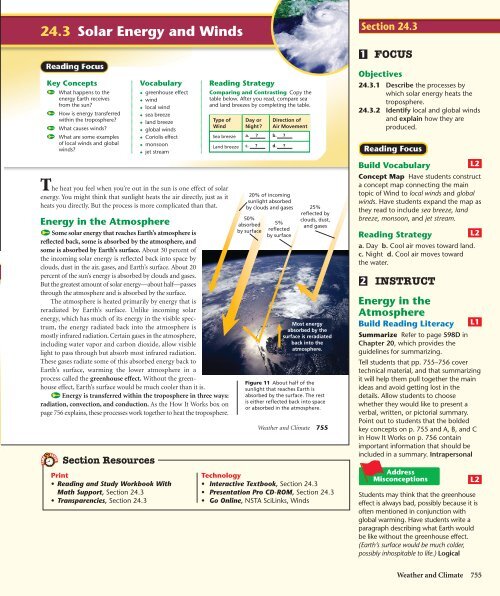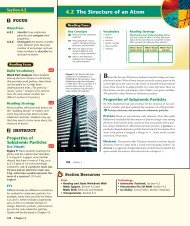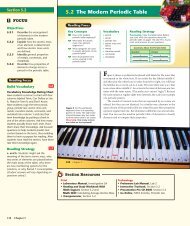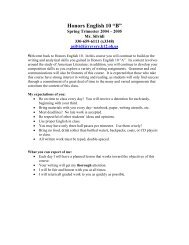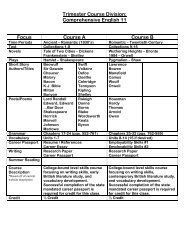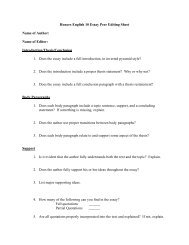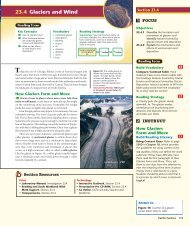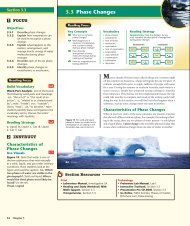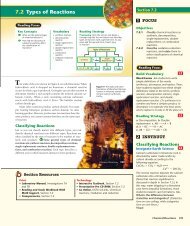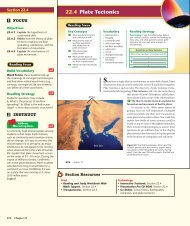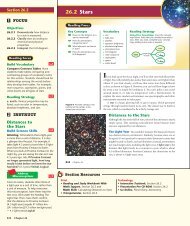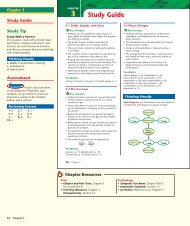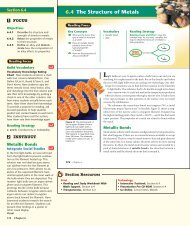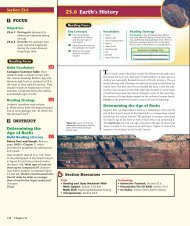24.3 Solar Energy and Winds
24.3 Solar Energy and Winds
24.3 Solar Energy and Winds
You also want an ePaper? Increase the reach of your titles
YUMPU automatically turns print PDFs into web optimized ePapers that Google loves.
<strong>24.3</strong> <strong>Solar</strong> <strong>Energy</strong> <strong>and</strong> <strong>Winds</strong><br />
Key Concepts<br />
What happens to the<br />
energy Earth receives<br />
from the sun?<br />
How is energy transferred<br />
within the troposphere?<br />
What causes winds?<br />
What are some examples<br />
of local winds <strong>and</strong> global<br />
winds?<br />
Vocabulary<br />
◆ greenhouse effect<br />
◆ wind<br />
◆ local wind<br />
◆ sea breeze<br />
◆ l<strong>and</strong> breeze<br />
◆ global winds<br />
◆ Coriolis effect<br />
◆ monsoon<br />
◆ jet stream<br />
Reading Strategy<br />
Comparing <strong>and</strong> Contrasting Copy the<br />
table below. After you read, compare sea<br />
<strong>and</strong> l<strong>and</strong> breezes by completing the table.<br />
Type of<br />
Wind<br />
Sea breeze<br />
L<strong>and</strong> breeze<br />
The heat you feel when you’re out in the sun is one effect of solar<br />
energy. You might think that sunlight heats the air directly, just as it<br />
heats you directly. But the process is more complicated than that.<br />
<strong>Energy</strong> in the Atmosphere<br />
Some solar energy that reaches Earth’s atmosphere is<br />
reflected back, some is absorbed by the atmosphere, <strong>and</strong><br />
some is absorbed by Earth’s surface. About 30 percent of<br />
the incoming solar energy is reflected back into space by<br />
clouds, dust in the air, gases, <strong>and</strong> Earth’s surface. About 20<br />
percent of the sun’s energy is absorbed by clouds <strong>and</strong> gases.<br />
But the greatest amount of solar energy—about half—passes<br />
through the atmosphere <strong>and</strong> is absorbed by the surface.<br />
The atmosphere is heated primarily by energy that is<br />
reradiated by Earth’s surface. Unlike incoming solar<br />
energy, which has much of its energy in the visible spectrum,<br />
the energy radiated back into the atmosphere is<br />
mostly infrared radiation. Certain gases in the atmosphere,<br />
including water vapor <strong>and</strong> carbon dioxide, allow visible<br />
light to pass through but absorb most infrared radiation.<br />
These gases radiate some of this absorbed energy back to<br />
Earth’s surface, warming the lower atmosphere in a<br />
process called the greenhouse effect. Without the greenhouse<br />
effect, Earth’s surface would be much cooler than it is.<br />
<strong>Energy</strong> is transferred within the troposphere in three ways:<br />
radiation, convection, <strong>and</strong> conduction. As the How It Works box on<br />
page 756 explains, these processes work together to heat the troposphere.<br />
Section Resources<br />
Print<br />
• Reading <strong>and</strong> Study Workbook With<br />
Math Support, Section <strong>24.3</strong><br />
• Transparencies, Section <strong>24.3</strong><br />
Day or<br />
Night?<br />
a. ?<br />
c. ?<br />
Direction of<br />
Air Movement<br />
b. ?<br />
d. ?<br />
20% of incoming<br />
sunlight absorbed<br />
by clouds <strong>and</strong> gases<br />
50%<br />
absorbed<br />
by surface<br />
5%<br />
reflected<br />
by surface<br />
25%<br />
reflected by<br />
clouds, dust,<br />
<strong>and</strong> gases<br />
Most energy<br />
absorbed by the<br />
surface is reradiated<br />
back into the<br />
atmosphere.<br />
Figure 11 About half of the<br />
sunlight that reaches Earth is<br />
absorbed by the surface. The rest<br />
is either reflected back into space<br />
or absorbed in the atmosphere.<br />
Weather <strong>and</strong> Climate 755<br />
Technology<br />
• Interactive Textbook, Section <strong>24.3</strong><br />
• Presentation Pro CD-ROM, Section <strong>24.3</strong><br />
• Go Online, NSTA SciLinks, <strong>Winds</strong><br />
Section <strong>24.3</strong><br />
1<br />
FOCUS<br />
Objectives<br />
<strong>24.3</strong>.1 Describe the processes by<br />
which solar energy heats the<br />
troposphere.<br />
<strong>24.3</strong>.2 Identify local <strong>and</strong> global winds<br />
<strong>and</strong> explain how they are<br />
produced.<br />
Build Vocabulary<br />
Concept Map Have students construct<br />
a concept map connecting the main<br />
topic of Wind to local winds <strong>and</strong> global<br />
winds. Have students exp<strong>and</strong> the map as<br />
they read to include sea breeze, l<strong>and</strong><br />
breeze, monsoon, <strong>and</strong> jet stream.<br />
Reading Strategy<br />
a. Day b. Cool air moves toward l<strong>and</strong>.<br />
c. Night d. Cool air moves toward<br />
the water.<br />
2<br />
Reading Focus<br />
INSTRUCT<br />
<strong>Energy</strong> in the<br />
Atmosphere<br />
Build Reading Literacy<br />
L2<br />
L2<br />
L1<br />
Summarize Refer to page 598D in<br />
Chapter 20, which provides the<br />
guidelines for summarizing.<br />
Tell students that pp. 755–756 cover<br />
technical material, <strong>and</strong> that summarizing<br />
it will help them pull together the main<br />
ideas <strong>and</strong> avoid getting lost in the<br />
details. Allow students to choose<br />
whether they would like to present a<br />
verbal, written, or pictorial summary.<br />
Point out to students that the bolded<br />
key concepts on p. 755 <strong>and</strong> A, B, <strong>and</strong> C<br />
in How It Works on p. 756 contain<br />
important information that should be<br />
included in a summary. Intrapersonal<br />
L2<br />
Students may think that the greenhouse<br />
effect is always bad, possibly because it is<br />
often mentioned in conjunction with<br />
global warming. Have students write a<br />
paragraph describing what Earth would<br />
be like without the greenhouse effect.<br />
(Earth’s surface would be much colder,<br />
possibly inhospitable to life.) Logical<br />
Weather <strong>and</strong> Climate 755
Section <strong>24.3</strong> (continued)<br />
<strong>Energy</strong> Transfer in<br />
the Troposphere L2<br />
<strong>Solar</strong> radiation heats Earth’s surface,<br />
which, in turn, transfers energy to the<br />
troposphere. <strong>Energy</strong> is released by Earth’s<br />
surface in the form of infrared radiation.<br />
Atmospheric gases—such as water vapor,<br />
carbon dioxide, <strong>and</strong> methane—absorb<br />
infrared radiation. These greenhouse<br />
gases also reradiate some of that energy<br />
back to Earth’s surface. This transfer of<br />
energy by radiation is very efficient, <strong>and</strong><br />
is the primary mechanism by which<br />
the troposphere is heated. Because in<br />
convection some heat energy is converted<br />
into kinetic energy, convection<br />
is a less efficient way of transferring heat<br />
to the troposphere. Because air is not a<br />
good heat conductor, conduction is the<br />
least significant way in which heat is<br />
transferred in the troposphere.<br />
Interpreting Diagrams The sun<br />
Visual<br />
For Enrichment<br />
Students can research the specific<br />
wavelengths of infrared radiation that<br />
are absorbed by each of the major gases<br />
in the atmosphere. Verbal, Portfolio<br />
Integrate Physics<br />
756 Chapter 24<br />
L3<br />
L2<br />
The sun emits energy over a wide range<br />
of wavelengths, from radio waves<br />
through X-rays. Slightly more than half<br />
of the sun’s radiation is in the visible <strong>and</strong><br />
ultraviolet spectra (10–750 nm). Most<br />
of the radiation in this range passes<br />
through the atmosphere <strong>and</strong> is absorbed<br />
by Earth’s surface, heating the l<strong>and</strong> <strong>and</strong><br />
water. These surfaces then radiate energy<br />
back into the atmosphere in the infrared<br />
spectrum (750–1000 nm). Certain gases<br />
in the atmosphere, including carbon<br />
dioxide <strong>and</strong> water vapor, efficiently<br />
absorb infrared radiation. This process is<br />
called the greenhouse effect, which is<br />
the accumulation of heat in the lower<br />
atmosphere through the radiation <strong>and</strong><br />
reradiation of energy. Ask, Why is<br />
only 20% of incoming solar energy<br />
absorbed by the atmosphere? (Most<br />
solar radiation is in the visible <strong>and</strong> ultraviolet<br />
range, which most atmospheric<br />
gases cannot absorb.) Which has more<br />
energy, infrared or ultraviolet<br />
radiation? (Ultraviolet) Logical<br />
<strong>Energy</strong> Transfer in<br />
the Troposphere<br />
<strong>Energy</strong> is transferred within the troposphere by radiation,<br />
conduction, <strong>and</strong> convection. Radiation from the sun heats<br />
Earth’s surface, which then radiates heat skyward. The air<br />
in direct contact with Earth’s surface is heated by<br />
conduction. Warm air near the surface exp<strong>and</strong>s <strong>and</strong> rises<br />
<strong>and</strong> cooler, denser air sinks, forming convection currents<br />
that move heat through the troposphere.<br />
Interpreting Diagrams Where does most of the energy<br />
in the troposphere originally come from?<br />
Radiation Much of the sun’s<br />
radiation reaches Earth’s<br />
surface, where it heats the l<strong>and</strong> <strong>and</strong><br />
water. L<strong>and</strong> <strong>and</strong> water radiate heat<br />
back into the atmosphere.<br />
756 Chapter 24<br />
Conduction The conduction<br />
process transfers heat from l<strong>and</strong><br />
<strong>and</strong> water directly to the few meters<br />
of air nearest Earth’s surface.<br />
Facts <strong>and</strong> Figures<br />
Radiation <strong>and</strong> Temperature The reason<br />
that the sun <strong>and</strong> the Earth emit different forms<br />
of radiation is because they have different<br />
temperatures. Hotter objects emit shorterwavelength<br />
radiation. Colder objects emit<br />
longer-wavelength radiation. The sun’s hot<br />
surface emits radiation in the shorter-<br />
<strong>Solar</strong><br />
radiation<br />
Infrared<br />
radiation<br />
Greenhouse effect<br />
When Earth’s surface is heated,<br />
much of this energy is radiated<br />
back as infrared radiation. Some<br />
of this radiation is absorbed by<br />
gases in the atmosphere. The<br />
process by which gases hold<br />
heat in the air is called the<br />
greenhouse effect.<br />
Convection Convection moves heat<br />
through the troposphere. As surface<br />
air is heated by radiation <strong>and</strong> conduction,<br />
rising warm air is replaced by denser,<br />
downward-flowing cool air.<br />
wavelength visible <strong>and</strong> ultraviolet spectrum.<br />
Earth’s cooler surface (including the people on<br />
it) emits radiation in the longer-wavelength<br />
infrared spectrum. Objects that are colder than<br />
freezing emit even longer-wavelength radiation,<br />
in the microwave spectrum.
Wind<br />
What happens when you open a vacuum-packed can of chips? You<br />
hear a rush of air, which is the sound of air moving from the highpressure<br />
area outside the can to the low-pressure area inside the can.<br />
A similar process occurs in the atmosphere.<br />
Air naturally flows from areas of higher pressure to areas of lower<br />
pressure. This flow is wind, which is the mainly horizontal movement<br />
of air. <strong>Winds</strong> are caused by differences in air pressure. Larger<br />
pressure differences produce stronger winds.<br />
Differences in air pressure are often caused by the unequal heating<br />
of Earth’s surface. As you’ve learned, the atmosphere is warmed largely<br />
by reradiation from Earth’s surface below it. As air is heated, it exp<strong>and</strong>s.<br />
As it becomes less dense, air rises. Cooler, denser air flows in to replace<br />
it. This process occurs on both local <strong>and</strong> global scales, producing local<br />
<strong>and</strong> global winds.<br />
Local <strong>Winds</strong><br />
On a hot summer day, there is often a cool breeze<br />
blowing in from the water to the beach. This breeze<br />
is an example of a local wind, a wind that blows<br />
over a short distance. Local winds are caused by<br />
the unequal heating of Earth’s surface within a<br />
small region.<br />
The breezes that occur where l<strong>and</strong> meets a<br />
large body of water are examples of local winds.<br />
Water has a higher specific heat than l<strong>and</strong>, <strong>and</strong> therefore<br />
takes longer to heat up <strong>and</strong> cool down. During<br />
the day, the sun heats the l<strong>and</strong> more quickly than it<br />
heats the water. The air above the l<strong>and</strong> becomes<br />
warmer than the air above the water. The warm air<br />
exp<strong>and</strong>s <strong>and</strong> rises, creating a lower-pressure area<br />
above the l<strong>and</strong>. The cooler air over the water flows<br />
toward the l<strong>and</strong>, creating a sea breeze.<br />
At night, these temperature <strong>and</strong> pressure conditions<br />
are reversed, as Figure 12 shows. L<strong>and</strong> cools<br />
off more quickly than water. The cooler air over<br />
l<strong>and</strong> has a higher density than the warmer air over<br />
water. The result is a l<strong>and</strong> breeze, where cooler air<br />
over l<strong>and</strong> moves toward water. <strong>Winds</strong> are named<br />
for the direction from which they originate—sea<br />
breezes begin over the ocean <strong>and</strong> l<strong>and</strong> breezes<br />
begin over l<strong>and</strong>.<br />
In which direction does a<br />
l<strong>and</strong> breeze blow?<br />
A<br />
B<br />
B<br />
Sea Breeze<br />
Cooler air<br />
moving toward<br />
the l<strong>and</strong><br />
L<strong>and</strong> Breeze<br />
Warm air<br />
rising<br />
Customize for English Language Learners<br />
Flowchart<br />
Tailor your presentation to ELL students by<br />
using a flowchart to help students visualize<br />
the sequence of events with minimal use of<br />
language. Title the flowchart The Path of<br />
For: Links on winds<br />
Visit: www.SciLinks.org<br />
Web Code: ccn-3243<br />
Warm air<br />
rising<br />
Cooler air<br />
Cooler air<br />
moving toward<br />
the water<br />
Figure 12 Sea breezes <strong>and</strong> l<strong>and</strong> breezes are local<br />
winds. A During the day, air pressure differences due to<br />
unequal heating cause a sea breeze. B At night, pressure<br />
differences are reversed, causing a l<strong>and</strong> breeze.<br />
Comparing <strong>and</strong> Contrasting How are l<strong>and</strong><br />
breezes <strong>and</strong> sea breezes different?<br />
Weather <strong>and</strong> Climate 757<br />
<strong>Energy</strong>. Use three boxes entitled Sun, Earth’s<br />
Surface, <strong>and</strong> Troposphere. Have students fill<br />
in the boxes to explain the energy transfer in<br />
their own words.<br />
Wind<br />
Wind Creation<br />
L2<br />
Purpose Students observe how winds<br />
are produced.<br />
Materials clear plastic tank, plastic<br />
wrap, 2 1-L beakers, water, hot plate<br />
or Bunsen burner, ice, wood splint<br />
(smoker), matches<br />
Procedure Fill one beaker about<br />
halfway with water <strong>and</strong> heat it to nearly<br />
boiling. Fill the other beaker with ice.<br />
Place the beakers inside the tank on<br />
opposite sides <strong>and</strong> cover the tank with<br />
plastic wrap. Cut a small hole in the wrap<br />
over the ice large enough to fit the splint<br />
through easily. Ask students which way<br />
they think the wind will blow. Light the<br />
splint, blow on it until it is smoking, <strong>and</strong><br />
insert it deep into the tank over the ice.<br />
Expected Outcome The smoke will<br />
sink over the ice, move across the tank,<br />
<strong>and</strong> rise over the hot water, making the<br />
movement of air in the convection<br />
current visible. Visual, Logical<br />
Local <strong>Winds</strong><br />
Build Science Skills<br />
L2<br />
Designing Experiments Have groups<br />
of students design an experiment to test<br />
whether a breeze over a lake is produced<br />
by the same process described on p. 757.<br />
Provide them with the following headings<br />
to fill in: Hypothesis, Materials, Procedure,<br />
<strong>and</strong> Observations. Students’ experiments<br />
may include observations of air pressure,<br />
temperature, <strong>and</strong>/or wind direction.<br />
Interpersonal, Portfolio<br />
Download a worksheet on winds<br />
for students to complete, <strong>and</strong> find<br />
additional teacher support from<br />
NSTA SciLinks.<br />
Answer to . . .<br />
Figure 12 They occur at different<br />
times <strong>and</strong> move in opposite directions.<br />
the water.<br />
A l<strong>and</strong> breeze blows<br />
from the l<strong>and</strong> toward<br />
Weather <strong>and</strong> Climate 757
Section <strong>24.3</strong> (continued)<br />
Global <strong>Winds</strong><br />
Use Visuals<br />
Figure 13 Identify 0, 30 S, 60 S,<br />
30 N, <strong>and</strong> 60 N. Explain that the global<br />
wind patterns shown in this figure remain<br />
fairly constant throughout the year,<br />
though the change of seasons does have<br />
some effect on the circulation of the<br />
atmosphere. Heating patterns change as<br />
the seasons change, <strong>and</strong> patterns of air<br />
pressure (<strong>and</strong> thus wind) change as a<br />
result. Point out that convection cells are<br />
vertical <strong>and</strong> reach to the top of the<br />
troposphere. Point to the convection cell<br />
between 0 <strong>and</strong> 30 S <strong>and</strong> ask, Which<br />
direction is this wind pattern felt on<br />
the ground? (Northwest) In which<br />
regions of Earth are the global winds<br />
moving generally from the east in a<br />
westerly direction? (0°–30° N, 0°–30° S,<br />
60° N–90° N, <strong>and</strong> 60° S–90° S) Why are<br />
the arrows in the 0–30 S region (over<br />
South America) curving to the left? (The<br />
northerly winds curve westward as the result<br />
of Earth’s rotation—or the Coriolis effect.)<br />
This figure can be used to help explain<br />
the movements of fronts <strong>and</strong> storms in<br />
Section 24.5 <strong>and</strong> global climate patterns<br />
in Section 24.7. Visual<br />
Convection Cells<br />
758 Chapter 24<br />
L1<br />
L2<br />
Purpose Students observe a convection<br />
cell produced in water.<br />
Materials 1-L beaker, water, hot plate<br />
or Bunsen burner, 5–10 drops of food<br />
coloring<br />
Procedure Fill the beaker with<br />
approximately 750 mL water. Place the<br />
beaker on a hot plate or Bunsen burner<br />
<strong>and</strong> heat water until some steam is rising,<br />
but before boiling. Turn off the heat<br />
source. Explain that convection cells are<br />
common phenomena in both air <strong>and</strong><br />
water on many scales, from global to<br />
local winds, <strong>and</strong> from ocean currents to<br />
coffee cups. Slowly add the drops of food<br />
coloring (they will spread quickly, so only<br />
add enough to make the convection cell<br />
visible). Ask students to explain what is<br />
causing the convection cell.<br />
Expected Outcome The food coloring<br />
will reveal the circulation of water in a<br />
convection cell before dissipating. This<br />
cell is produced when warm water<br />
touches surface air, cools, <strong>and</strong> sinks again<br />
to the bottom. Visual, Logical<br />
Warm air rises<br />
at the equator until<br />
it reaches the top<br />
of the troposphere.<br />
The circulating<br />
air patterns<br />
are called<br />
“convection cells.”<br />
Figure 13 Earth is surrounded by<br />
a set of global wind belts.<br />
Figure 14 For hundreds of years,<br />
sailing ships have relied on global<br />
winds to transport cargo across<br />
the oceans.<br />
Interpreting Visuals Which<br />
b<strong>and</strong> of global winds would a<br />
sailing ship use to move cargo<br />
from Canada to Europe?<br />
758<br />
Facts <strong>and</strong> Figures<br />
Dry air sinks<br />
over the world’s<br />
deserts.<br />
Where the Wind Dies While trade winds<br />
<strong>and</strong> westerlies occur where convection cells<br />
blow across the surface, there are also areas<br />
where the wind dies out. These occur where<br />
the convection cells produce areas of rising or<br />
sinking air, such as at the equator, at 30 north<br />
<strong>and</strong> south latitude, <strong>and</strong> at 60 north <strong>and</strong> south<br />
latitude. The area of low winds at the equator<br />
is referred to as the doldrums, <strong>and</strong> the low<br />
Trade winds<br />
Westerlies<br />
Westerlies<br />
Earth’s rotation<br />
Doldrums<br />
Trade winds<br />
Polar easterlies<br />
Very cold air sinks<br />
at the poles <strong>and</strong> flows<br />
outward, creating winds<br />
called polar easterlies.<br />
The area where<br />
the trade winds<br />
die out is known<br />
as the doldrums.<br />
Global <strong>Winds</strong><br />
<strong>Winds</strong> that blow over long distances from a specific direction are<br />
called global winds. These winds are part of a worldwide pattern of<br />
air circulation. Global winds are caused by the unequal heating of<br />
Earth’s surface across a large region.<br />
Convection Cells Global winds move in a series of huge b<strong>and</strong>s<br />
called convection cells. As you can see in Figure 13, these b<strong>and</strong>s look<br />
like loops from the side. These b<strong>and</strong>s are caused by temperature variations<br />
across Earth’s surface. At the equator, for example, temperatures<br />
tend to be warmer than at other latitudes. Warm air rises at the equator,<br />
creating a low-pressure region. This warm air is replaced by cooler<br />
air brought by global winds blowing near the surface. Higher in the<br />
atmosphere, air blows away from the equator toward the poles. Similar<br />
convection cells cover large b<strong>and</strong>s of latitude across Earth.<br />
The trade winds are wind belts just north <strong>and</strong> south of the equator.<br />
In the Northern Hemisphere, they blow from the northeast to the southwest.<br />
The prevailing westerlies occur between 30° <strong>and</strong> 60° latitude in<br />
both hemispheres. These winds generally blow from west to east over<br />
much of North America. The polar easterlies extend from 60° latitude to<br />
the poles in both hemispheres. Trade winds, westerlies, <strong>and</strong> polar<br />
easterlies are examples of global winds.<br />
wind regions at 30 north <strong>and</strong> south latitude<br />
are called the horse latitudes. This name has<br />
a gruesome historical origin. Colonial sailors<br />
traversing the Atlantic would frequently get<br />
stuck around 30 N when the wind died. To<br />
survive at sea with a limited supply of fresh<br />
water on board (<strong>and</strong> to lighten the ship’s<br />
weight) the sailors would throw a few horses
If Earth were not rotating on its axis, global winds would move in<br />
roughly straight paths from the poles to the equator. However, because<br />
Earth rotates, global winds move in a curved path between the poles<br />
<strong>and</strong> the equator. Notice in Figure 13 that global winds curve to the<br />
right in the Northern Hemisphere <strong>and</strong> to the left in the Southern<br />
Hemisphere. The curving effect that Earth’s rotation has on all freemoving<br />
objects, including global winds, is called the Coriolis effect. If<br />
Earth were not rotating, a rocket launched from the North Pole toward<br />
the equator would move in a straight line, as shown in Figure 15.<br />
However, because Earth is rotating underneath the rocket, the rocket<br />
would appear to an observer on Earth to curve to the right. Similary,<br />
Earth’s rotation causes global winds to curve.<br />
Monsoons Seasonal changes in the heating of Earth’s surface affect<br />
the circulation of the atmosphere. A monsoon is a wind system that is<br />
characterized by seasonal reversal of direction. Monsoons are similar to<br />
l<strong>and</strong> <strong>and</strong> sea breezes except that they occur on a much wider scale <strong>and</strong><br />
longer time frame. For example, the summer monsoon that occurs over<br />
much of South <strong>and</strong> Southeast Asia blows warm, humid air from the<br />
ocean onto l<strong>and</strong>. As this air rises over l<strong>and</strong>, it cools <strong>and</strong> brings heavy<br />
rainfall to parts of that region. In winter the monsoon reverses, blowing<br />
from l<strong>and</strong> onto water <strong>and</strong> bringing drier weather.<br />
Jet Stream Global wind patterns are also affected by fast-moving<br />
streams of air at high altitudes. A belt of high-speed wind in the upper<br />
troposphere is called a jet stream. Jet streams are caused by great differences<br />
in air pressure that develop at high altitudes.<br />
Section <strong>24.3</strong> Assessment<br />
Reviewing Concepts<br />
1. What happens to solar energy when it<br />
reaches Earth’s atmosphere?<br />
2. Explain how energy is transferred within<br />
the troposphere.<br />
3. What causes the wind to blow?<br />
4. How are local winds <strong>and</strong> global winds<br />
similar? How are they different?<br />
5. What are monsoons, <strong>and</strong> what causes them?<br />
Critical Thinking<br />
6. Relating Cause <strong>and</strong> Effects How does the<br />
Coriolis effect influence global wind patterns?<br />
Section <strong>24.3</strong> Assessment<br />
1. <strong>Solar</strong> energy is distributed in three ways:<br />
some is reflected, some is absorbed by the<br />
atmosphere, <strong>and</strong> some is absorbed by Earth’s<br />
surface.<br />
2. <strong>Energy</strong> is transferred within the troposphere<br />
by radiation, convection, <strong>and</strong> conduction.<br />
3. Wind is caused by differences in air<br />
pressure between different locations.<br />
4. Both local <strong>and</strong> global winds are produced<br />
by differences in air pressure that result from<br />
A<br />
Non-rotating Earth<br />
Movement of<br />
rocket<br />
Movement of<br />
rocket<br />
Equator<br />
Equator<br />
7. Applying Concepts You <strong>and</strong> your family<br />
vacation at a cabin on the shore of a large<br />
lake. At night, you notice that a breeze blows<br />
over your cabin toward the lake. Explain what<br />
causes the wind to blow in that direction.<br />
Thermal <strong>Energy</strong> Recall what you learned<br />
in Chapter 16 about the specific heat of<br />
water. Use this information to explain why<br />
l<strong>and</strong> <strong>and</strong> sea breezes undergo daily reversals<br />
in direction.<br />
B<br />
Direction of<br />
Earth’s rotation<br />
Rotating Earth<br />
Figure 15 The Coriolis effect<br />
causes free-moving objects, such<br />
as rockets <strong>and</strong> global winds, to<br />
move in a curved path. A A rocket<br />
launched from the North Pole<br />
toward the equator would move<br />
in a straight line if Earth were not<br />
rotating. B The Coriolis effect<br />
causes such a rocket to appear to<br />
curve to the right. Similarly, the<br />
Coriolis effect causes global winds<br />
to curve to the right in the<br />
Northern Hemisphere.<br />
Weather <strong>and</strong> Climate 759<br />
the unequal heating of Earth’s surface. For<br />
local winds, this unequal heating takes place<br />
within a small region, <strong>and</strong> the resulting wind<br />
blows over only a short distance. In contrast,<br />
global winds are caused by unequal heating<br />
across a large area, <strong>and</strong> blow over long<br />
distances for extended periods of time.<br />
5. Monsoons are large wind systems that<br />
have seasonal reversals of direction. They are<br />
caused by air pressure differences that result<br />
from the unequal heating of air above the<br />
ocean <strong>and</strong> l<strong>and</strong>.<br />
3<br />
ASSESS<br />
Evaluate<br />
Underst<strong>and</strong>ing<br />
Ask students to create a flowchart<br />
describing how local winds are created.<br />
Reteach<br />
L2<br />
L1<br />
Use Figure 13 to explain convection cells<br />
<strong>and</strong> the Coriolis effect.<br />
Water has a high specific heat, higher<br />
than that of l<strong>and</strong>. As a result, water<br />
warms up slower during the day <strong>and</strong><br />
cools down slower at night than l<strong>and</strong>.<br />
This affects the temperature of the air<br />
above the water <strong>and</strong> l<strong>and</strong>. L<strong>and</strong> <strong>and</strong> sea<br />
breezes are created by this daily cycle of<br />
unequal heating of air in coastal regions.<br />
If your class subscribes to<br />
the Interactive Textbook, use it to<br />
review key concepts in Section <strong>24.3</strong>.<br />
Answer to . . .<br />
Figure 14 A sailing ship would use<br />
the westerlies to move cargo from<br />
Canada to Europe.<br />
6. The Coriolis effect causes global winds to<br />
turn to the right in the Northern Hemisphere<br />
<strong>and</strong> to the left in the Southern Hemisphere.<br />
7. When night falls, the lake water remains<br />
warm as the l<strong>and</strong> cools off quickly. The warmer<br />
air over the water has a lower pressure than<br />
the cooler air over the l<strong>and</strong>. The result is a l<strong>and</strong><br />
breeze, which is when the cooler air over l<strong>and</strong><br />
moves toward water.<br />
Weather <strong>and</strong> Climate 759


